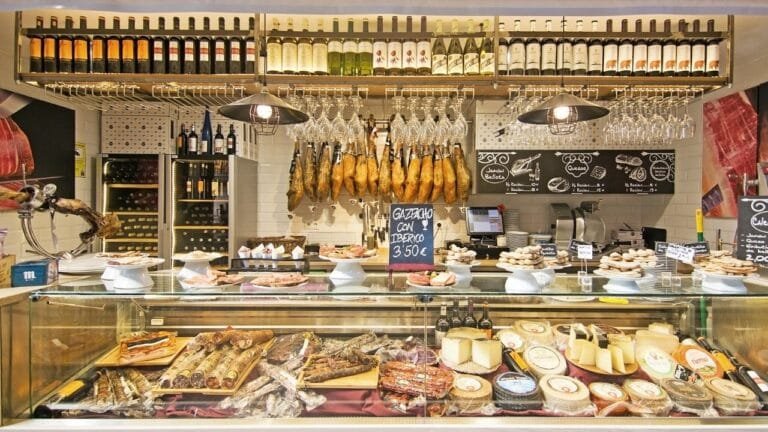While Spanish cuisine brings to mind tortilla de patatas, patatas bravas, and pimientos de padrón, Mallorca has its own flavors entirely, shaped by the sea, the mountains, and the Mediterranean sun. From the rich, paprika-spiced sobrassada to the delicate, flaky spirals of the emblematic ensaïmada, the island’s food reflects centuries of farming, baking, and celebrating with the seasons. In this guide, you’ll discover the must-try dishes, local specialities, and food festivals that make eating in Mallorca a journey into its culture.
Bakery
Your trip to Mallorca is not complete without stepping into a Mallorcan bakery, or forn. It is the quickest and simplest way to get the necessary infusion of Mallorcan gastronomy into your day, as well as trying a wider variety of things. Forn is Catalan for horno, or oven. Follow the smell of baking dough. That being said, the glass case can be overwhelming, so here’s your cheat sheet:
Sweet Treats
Ensaïmada
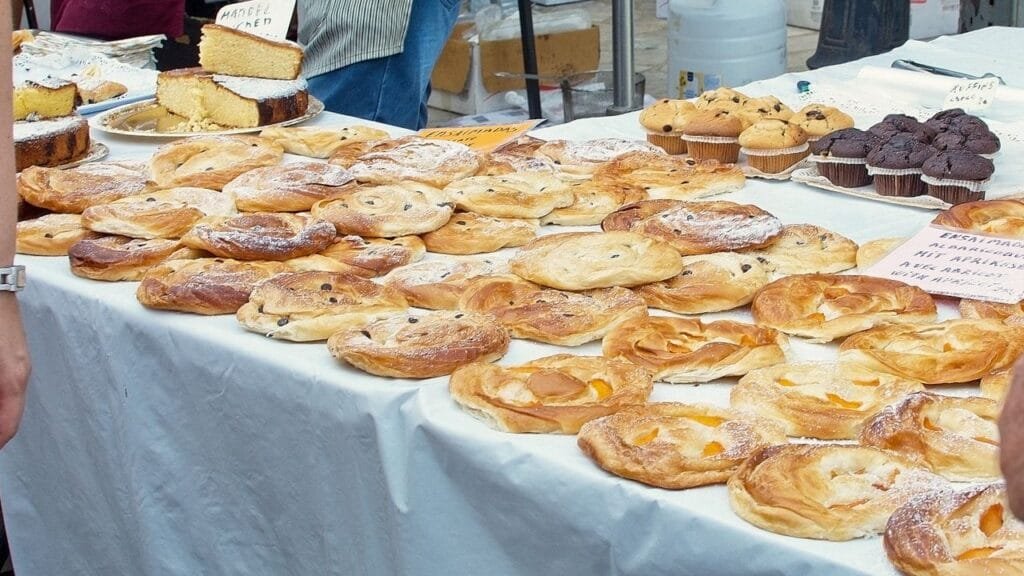
Ensaïmadas are easily the most iconic Mallorcan sweet treat, beloved by locals and tourists of the island. If you see octagonal boxes being toted through the airport, they’re filled with the emblematic spiraled pastry. It is light and melts in your mouth, delicious plain and further elevated with toppings and fillings.
The most common toppings are apricot, apple, cream, and cabello de angel, a type of pumpkin marmalade. You can also find ones filled with chocolate. I also would recommend the tajada ensaïmada, topped with candied fruit and sobrasada, a paprika-rich local soft sausage, for a combination of savory and sweet. It’s most common around Carnival, but you can find it in some forns year-round.
Note: Ensaïmades are not vegetarian friendly as they are made with saïm, pork lard (also known as manteca in Spanish if you need to ask).
Coca de Patata
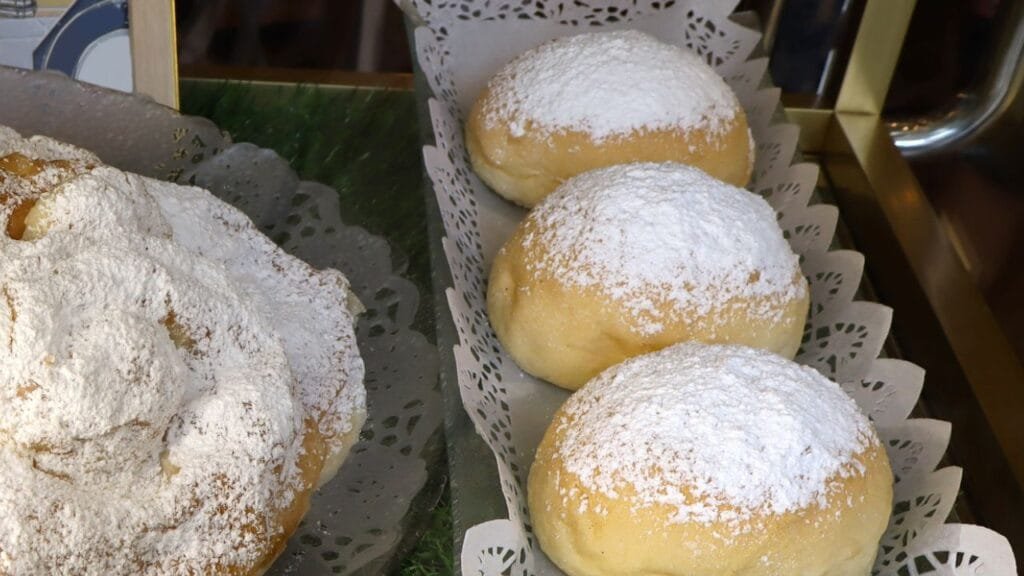
Coca de patata is a lightly sweet, fluffy potato roll typically topped with powdered sugar. It’s from Valldemossa and I suggest that it should be enjoyed in Valldemossa. In the winter, it is best enjoyed with a rich hot chocolate, and in the summer, an almond granizado. If you don’t have a big sweet tooth, this is a good choice. It works so well with hot chocolate because it isn’t that sweet; it’s more akin to a lightly sweet roll than a pastry.
Note: Cocas de Patata are also commonly made with pork lard.
Cremadillos
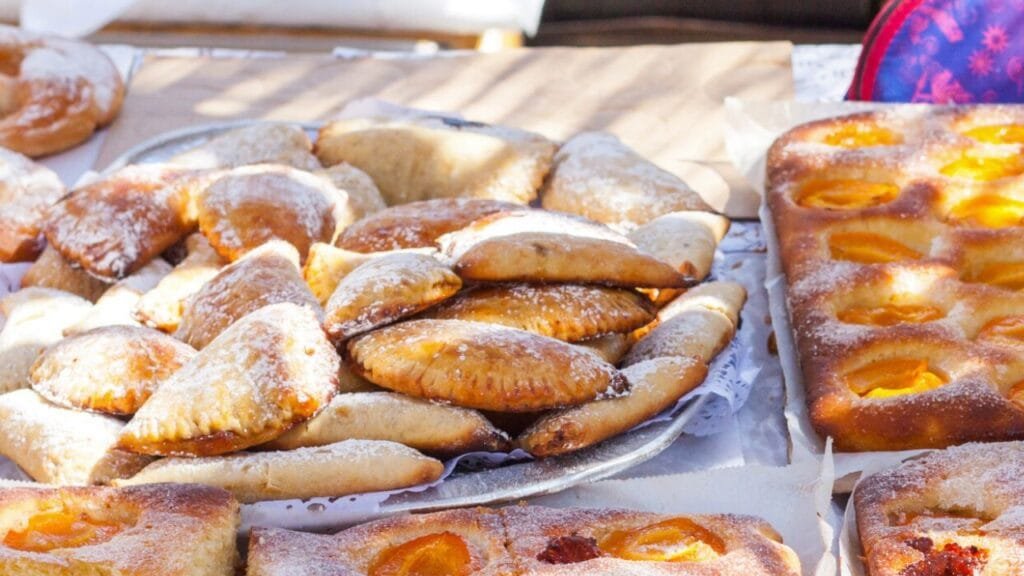
Cremadillos are a flaky, carmelized, crispy, half moon-shaped pastry typically filled with cream or cabello de angel, although the fillings can vary. (A market stall in Soller sold orange-filled ones and it was one of the best things I’ve eaten). It reminds me of an American-style fried pie, but it is baked rather than fried, yet retains a crunch in the thin puff pastry. It is quite heavy and rich, but you can usually find mini-cremadillos that are the perfect size to have a little sweet treat with your coffee.
Cuarto
Cuarto is a simple sponge cake commonly topped with powdered sugar and eaten with hot chocolate or almond ice cream. It is light and airy.
Gatò de Almendra
Gatò is another typical cake, but one that makes good use of the island’s almond crop. Rather than flour, it’s made with a base of crushed almonds. It is also delicious with almond ice cream.
Robiol
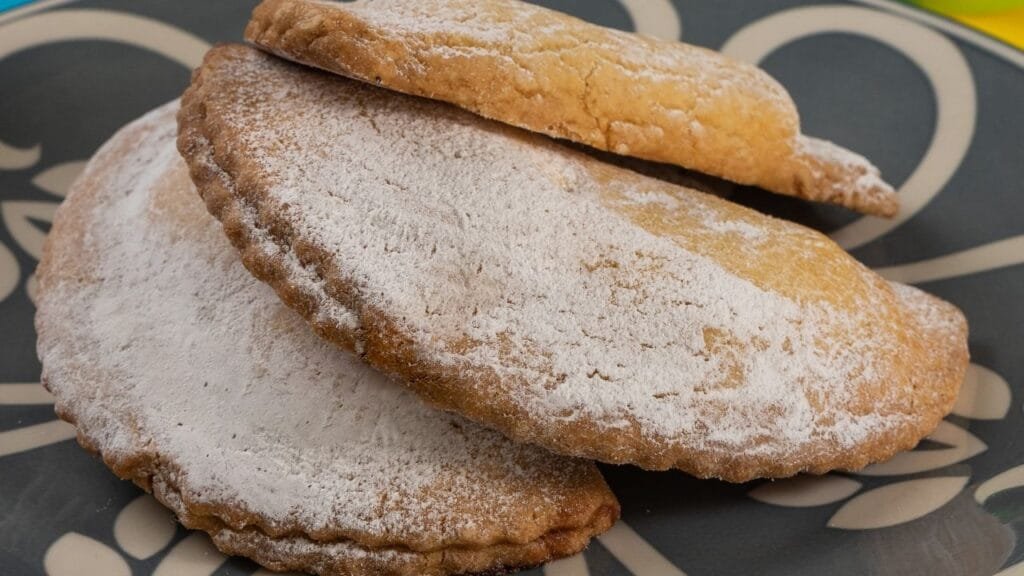
Robiols are a half moon-shaped filled cookie typically eaten around Holy Week, but found year-round. They are usually filled with cheese, cream, or cabello de angel. They are normally baked, but can be fried. They look similar to cremadillos, but less thick and without the sugar glaze. There are savory ones as well.
Note: They are commonly made with pork lard.
Coca de albaricoque
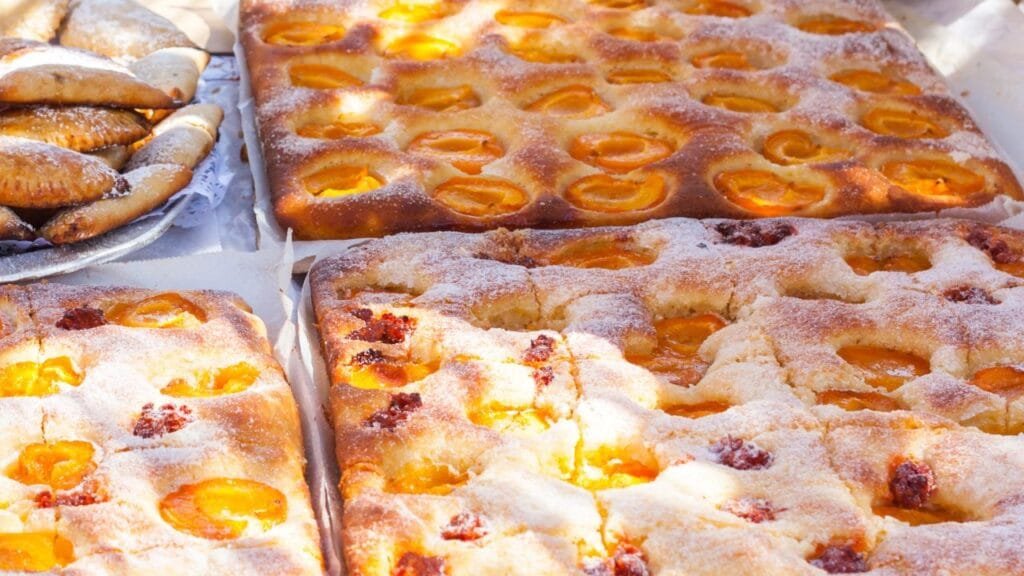
Coca de albaricoque is a light, spongy potato cake topped with apricots and powdered sugar. And like many Mallorcan pastries, it can be topped with sobrasada as well for a sweet and savory combination.
Note: It is commonly made with pork lard.
Crespells
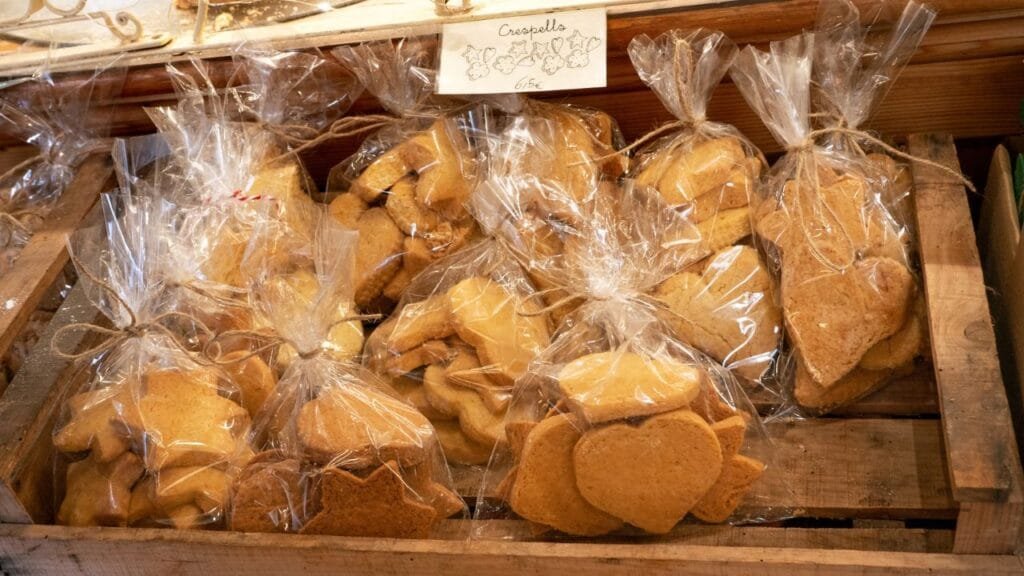
Crespells are a traditional Easter cookie that are also found and eaten year-round. You can find them in a variety of shapes and sizes. They can be topped with powdered sugar or chocolate.
Note: They are commonly made with pork lard.
Duquesa
Duquesas are small cakes with a delicate crust and cottage cheese filling with hints of lemon and cinnamon. They look like mini cheesecakes.
Note: These also can be made with pork lard.
Cardenal de Lloseta
The Cardenal de Lloseta is a light and airy layered dessert containing sponge cake, merengue, and whipped cream. It originates from Forn de Baix de Lloseta, in the small town of Lloseta, near Inca.
Savory Goodies
Coca Trampò
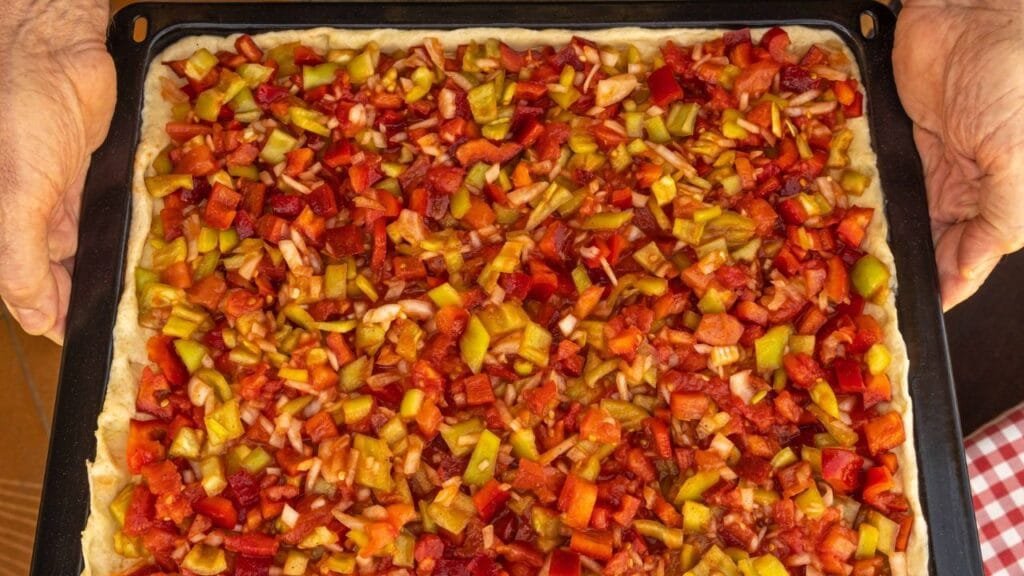
Coca trampò looks like a Mallorcan pizza. You can get slices of it in bakeries for the road. It is basically a flatbread topped with vegetables—typically tomato, peppers, and onion. If you ever come across a goat cheese and onion one, I also highly recommend it.
Note: The coca is often made with pork lard.
Panades
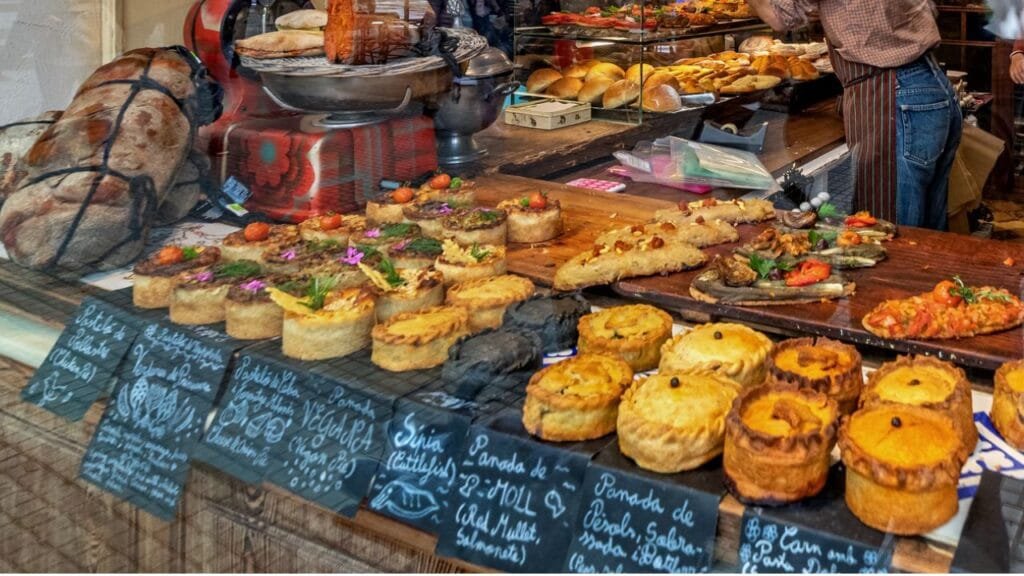
Mallorcan empanadas, or panades, are not to be confused with the Argentinian ones. These look more similar to a handheld pie, can be made with a sweet or savory crust, and are typically filled with pork and peas. They’re most associated with Easter, especially the lamb version, but you can find them in forns year-round.
Cocarroi
Cocarroi looks a bit more similar to the Argentinian empanadas. They are a half-moon shaped savory pastry stuffed with vegetables—such as spinach, leeks, cauliflower, onion, etc.—and also even pine nuts and raisins.
Note: the dough is frequently made with pork lard.
Bakery Recommendations
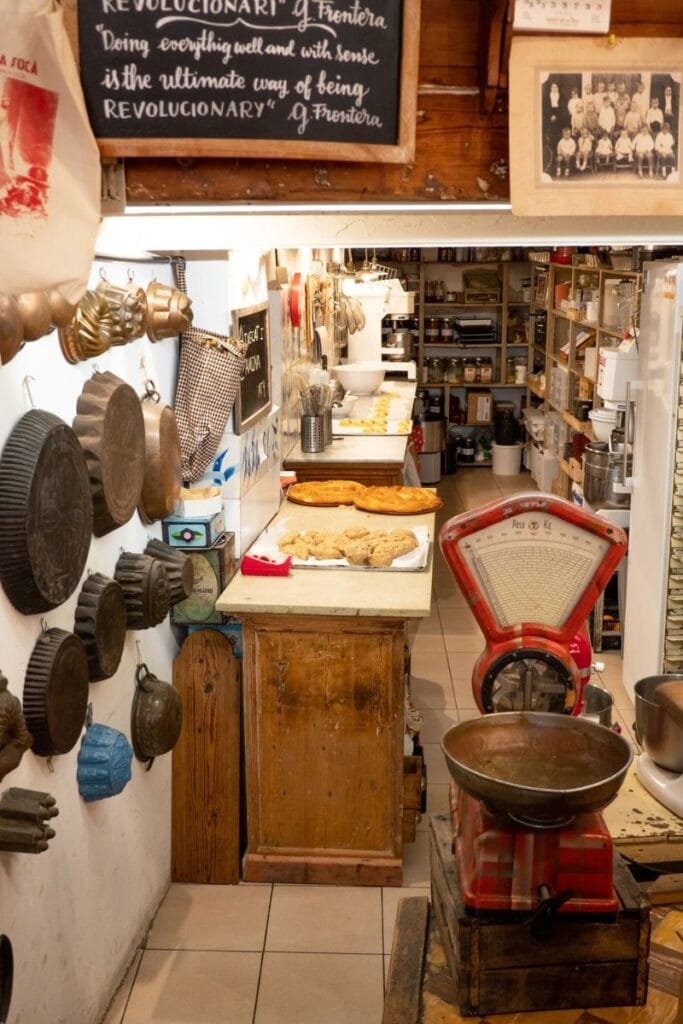
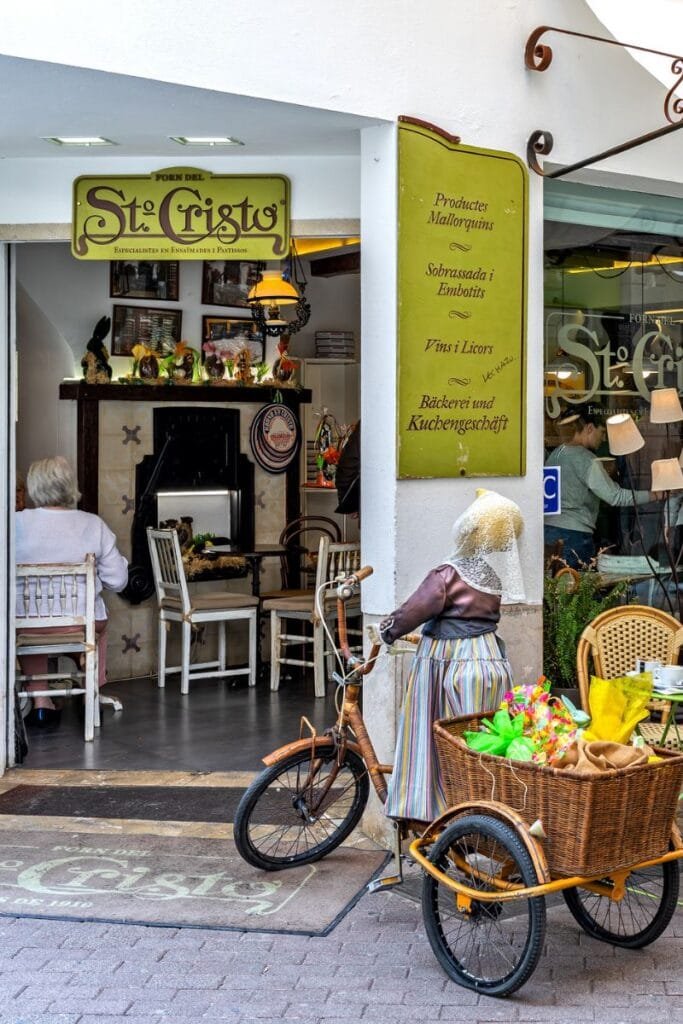
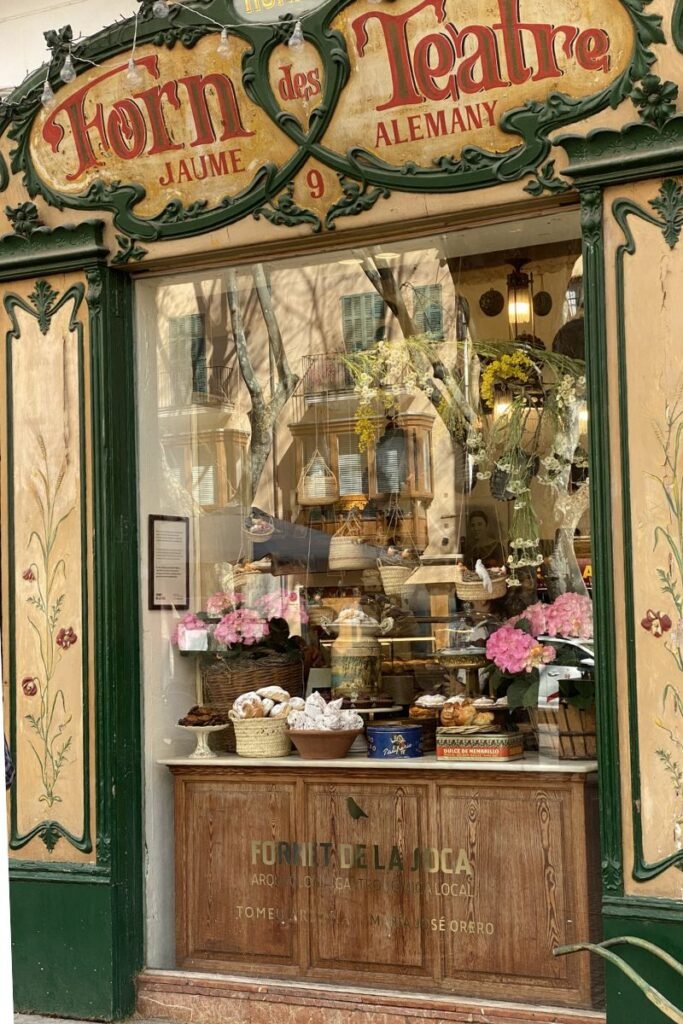
On Calle Sindicat, right across from the Flying Tiger Copenhagen store, you have Panaderia S’Estació, my personal favorite. Besides having delicious ensaïmadas, they have a wide variety of Mallorcan goodies. The best part? The floor is glass so you can watch them preparing different items, whether they’re rolling out dough, scorching the top of their ensaïmada with crema quemada, or preparing fillings. The interior makes you feel like you’re in an antique kitchen in the countryside, all dark wood, stone, and antiques.
Perhaps the most iconic—and certainly photogenic—bakery is Fornet de la Soca. It has a spectacular façade and window display, but it is also home to a wide variety of local baked goods. Besides the standard Mallorcan things, they also have specialty items like bread made with xeixa, an ancient grain native to the island.
If you’d like a sit-down experience, you have to check out Ca’n Joan de s’Aigo, an establishment that was founded in 1700. Each location is beautiful, but especially the original in Old Town. It’s a great place to enjoy a gatò with almond ice cream because they have excellent ice creams as well as pastries.
Santo Cristo is also a beloved bakery with locations around Palma and the island. If you see an ensaïmada box being toted through the airport, odds are it is from this bakery.
Deciphering a Mallorcan Menú del Día
If you are faced with a Mallorcan menú del día, there most likely will be many things you do not know what they are. While you can find more typically “Spanish” fare, any local restaurant worth its salt will offer more local dishes. Note: Vegetarians, like with the pastries, assume that meat or pork lard is involved in some way and ask if in doubt.
Tumbet
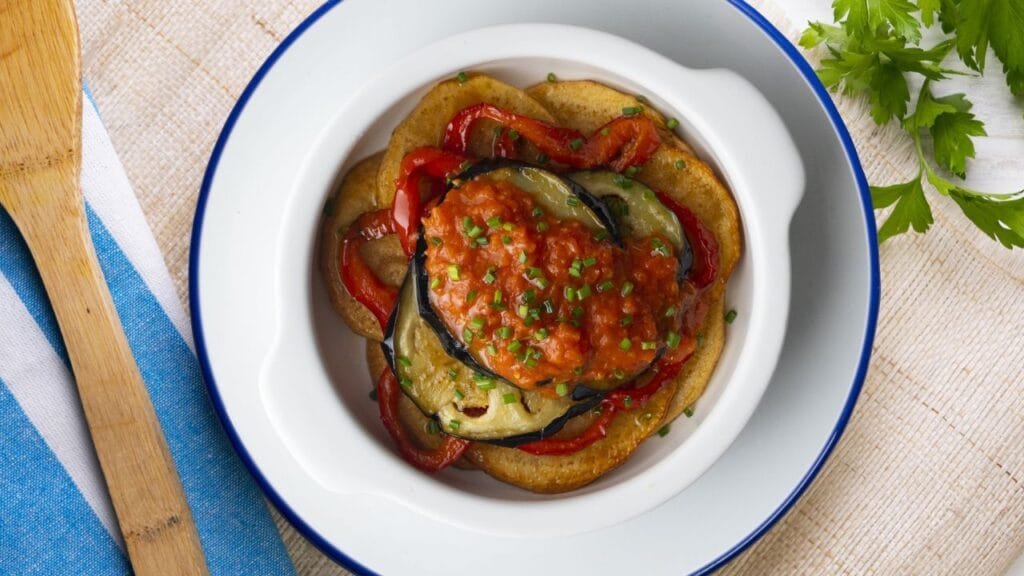
There aren’t so many vegetarian friendly dishes (or even pastries) in Mallorca, but the incredibly delicious tumbet is one of them! It is basically a Mallorcan version of ratatouille, made with potatoes, eggplants, peppers, and tomatoes fried in olive oil. It is common to add fried eggs to the top, but it is also great on its own.
Frit Mallorquín
Frit mallorquín, as the name implies, consists of fried meat along with vegetables. A traditional frit is made with potatoes, peppers, onion, mushrooms, garlic, fennel. The meat can vary, but it is traditionally made with lamb offal. Other versions can contain liver, heart, and cooked blood. There is also a delicious seafood version if you’re not quite brave enough.
Sopa Mallorquina
Sopa Mallorquína is a bit more akin to a vegetable stew than a soup. It can be made with cabbage, cauliflower, tomatoes, onion, garlic, vegetable broth, and thin slices of brown bread. The vegetables can vary but dried, thin slices of brown bread is a constant. It is a soup you can eat with a fork given that the bread soaks up all the broth. It is a very cozy, healthy dish to enjoy in the winter.
Variat
If you are an indecisive person who loves tapas, you will love the variat. Essentially, it is a plate filled with a variety of tapas, like ensaladilla rusa, frito mallorquín, albondigas, calamares, etc. In summary, it is a bit of everything.
Arròs Brut
Arròs brut, or arroz brut, is a brothy, soupy rice dish that is typically prepared in the winter. While its preparation can vary, at its core, it is prepared with a hearty meat broth, meat, and some mixture of seasonal vegetables (onion, red pepper, tomato, and green beans for instance). It also can contain aromatic spices like cinnamon and saffron.
Caragols
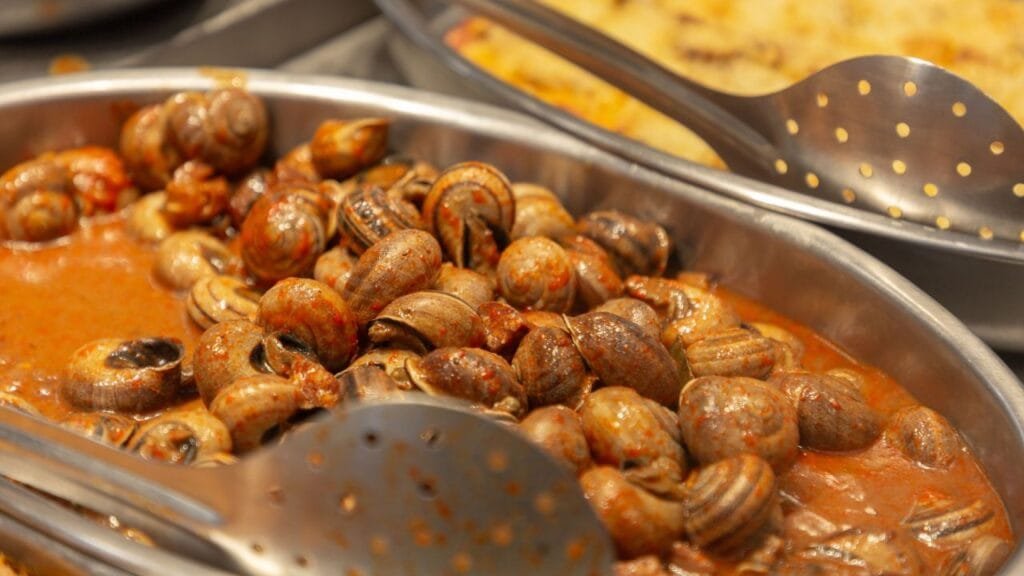
Caragols, or snails, aren’t just popular in France. You can find the Mallorcan version—cooked in herbs and spices—in tapas bars where they are often served with aioli.
Sobrasada
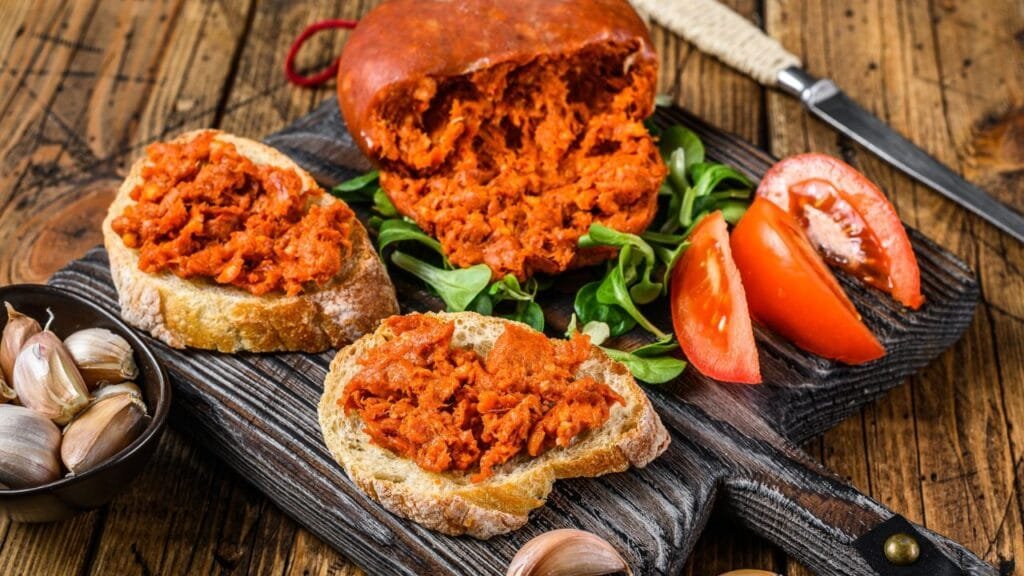
Sobrasada is a delicious, paprika-rich spreadable cured sausage that is easily incorporated in many other dishes on Mallorca, from ensaïmadas and pa amb oli to tortilla de patatas and even pizza. It is delicious and versatile. The simplest way to enjoy it is on bread with a bit of honey. Its production is regulated as it does carry the I.G.P (Protected Geographical Indication) seal and there are two types: Sobrasada de Mallorca (made with all pig breeds) and Sobrasada de Mallorca de cerdo negro (the more traditional one made with Mallorcan black pigs).
Butifarrón
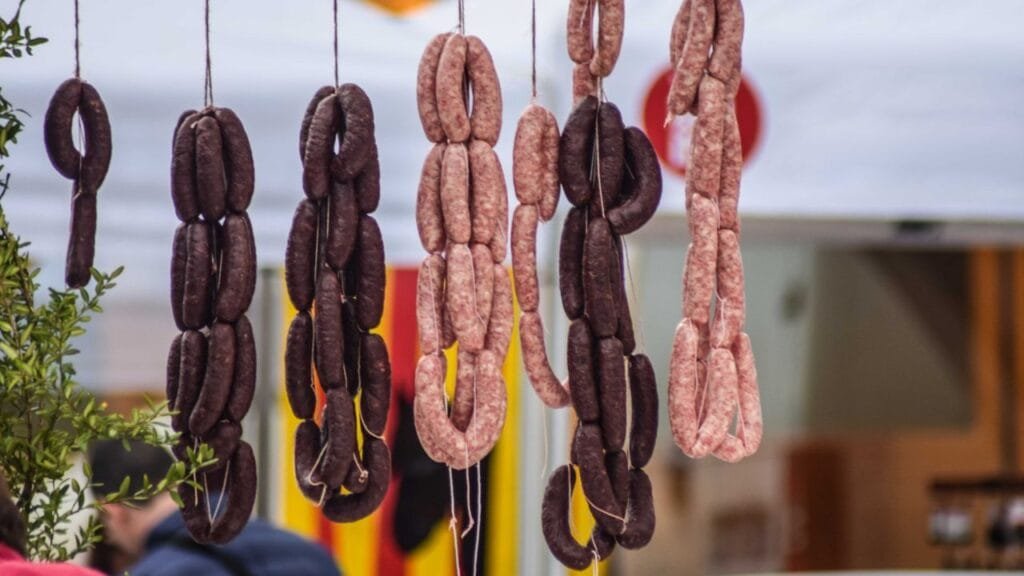
Butifarrón is a cooked sausage that contains pork blood as well as pine nuts and spices like anise, cinnamon, cloves, and nutmeg.
Bunyols
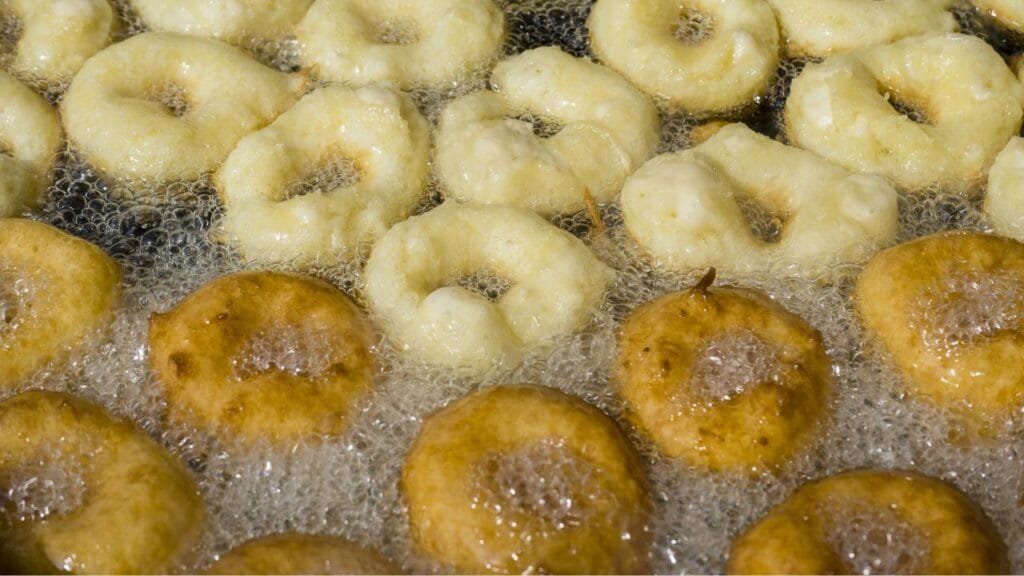
Bunyols are basically a fried potato donut, best dusted with powdered sugar. These are most commonly found in the autumn as they are traditionally prepared and eaten between October 21st (Day of the Virgins) and November 1st (All Saints Day). Traditionally, boys would serenade girls and the girls would give them bunyols for Dia de les Verges. While this isn’t so common anymore, many schools do still celebrate with bunyols and flowers. But if you smell frying dough in October, follow it because these are best eaten hot and out of a paper bag. Usually, there is a stand in front of El Corte Ingles on Avenidas. Xurreria Rosaleda also has them during the autumn if you’d like a sit-down experience.
Pa amb oli
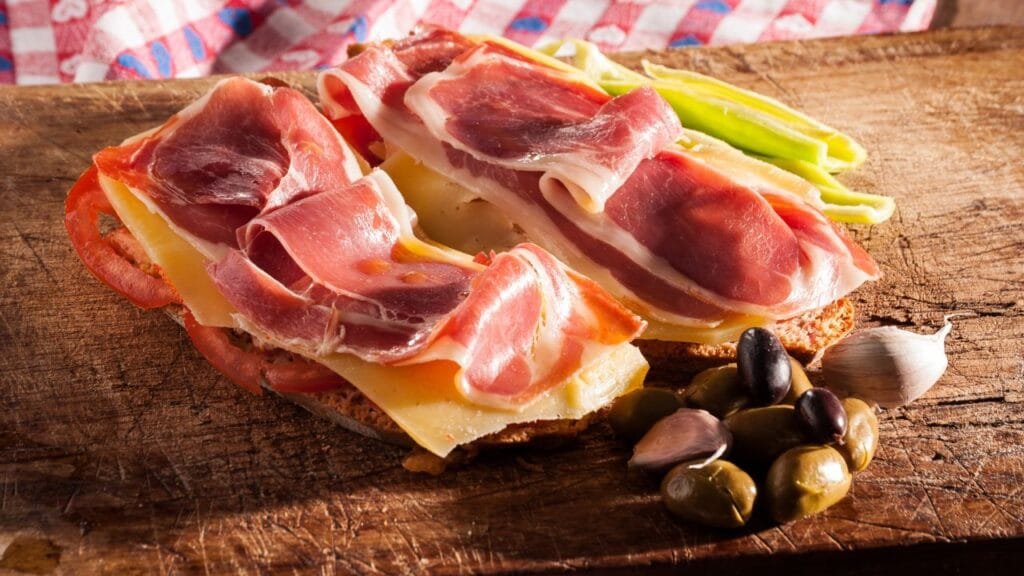
Pa amb oli is a Mallorcan staple. At its core, it is dense brown Mallorcan bread with tomato and olive oil. But the toppings are where it gets interesting, because the sky is the limit. You can add cured meats and cheeses (jamón iberico and Mahon cheese are a solid option), pork, seafood, tortilla de patatas, sobrasada . . . anything your heart desires. Sierra de Segura in S’Escorxador has a wide selection (I would recommend the sobrasada with honey and goat cheese and the mushrooms al ajillo). They are great for sharing.
Llonguet
Llonguet specifically refers to a type of Mallorcan bread roll, but it is also used interchangeably to refer to the sandwich that is made with this roll. Like with pa amb oli, the bread is what gives it the identity, but you can use a wide variety of sandwich fillings. Again, sobrasada with honey is a popular and very Mallorquin one. In Palma, Café Canamunt near Plaça d’Espanya has a great selection with unique twists. In Can Pastilla, Bon Vent also has really good ones that you can enjoy by the beach.
Beverages
To round off your journey into Mallorcan gastronomy, don’t forget to sample the island’s distinctive drinks, which range from herbal liqueurs to rich chocolate milk.
Hierbas
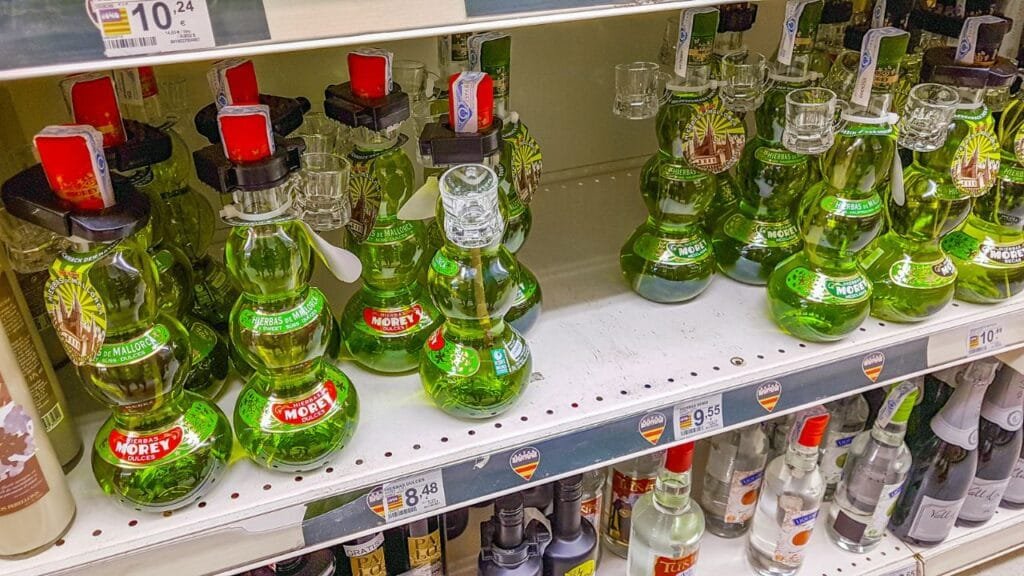
Hierbas is a Mallorcan herbal liquor made with aromatic herbs like anise, chamomile, fennel, mint, orange, rosemary, lemon, lemon verbena, and marjoram. It had a medical origin, but is now enjoyed as an after-dinner digestif—or more liberally at festivals. “Hierbas de Mallorca” are exclusively produced on Mallorca, having a protected geographic denomination of origin. One of the most well-known brands is Túnel in its signature green bottle. The liquor itself can be either green or amber. It also can be made at home, traditionally prepared in the spring or early autumn.
Laccao
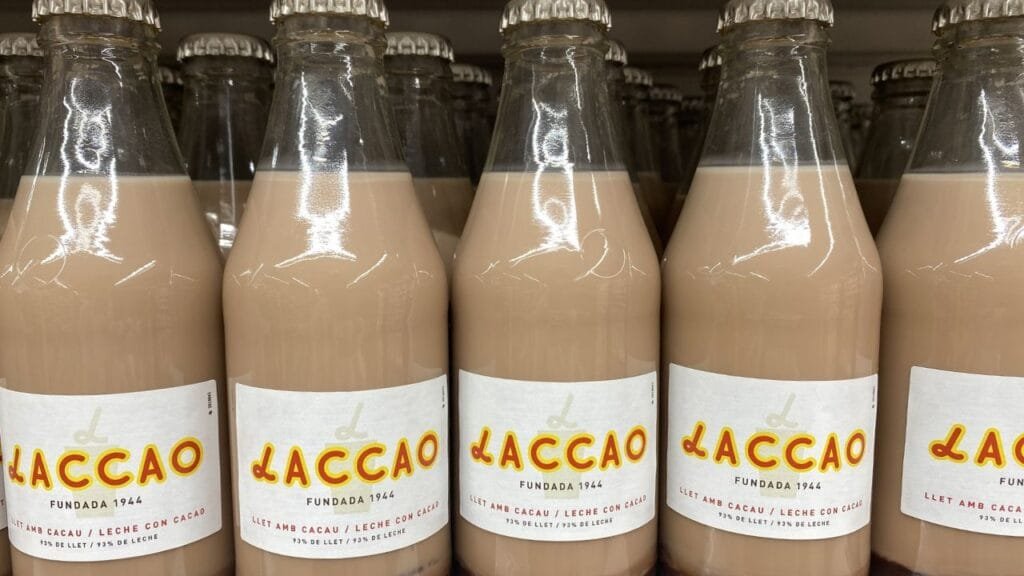
Laccao is a rich, delicious chocolate milk that you can find nearly everywhere in Mallorca, from the glass cases of bakeries and bars to supermarkets of all sizes. Spain has a soft spot for chocolate milk with different regions having their preferred brands. For instance, Catalunya has their beloved Caccaolat, but Mallorca has its Laccao—and yes, there is a rivalry. This Mallorcan brand dates back to the 1940s.
Honorable Mention: Xoriguer
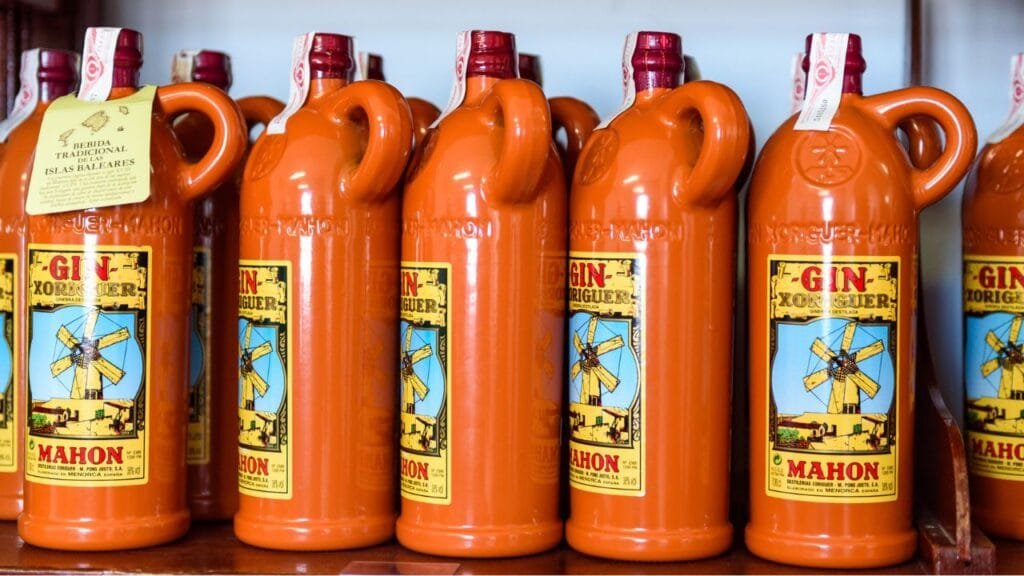
Xoriguer is a gin brand from neighboring Menorca, packed with Mediterranean flavor and juniper berries.
Ingredients
Mallorca’s incredibly beautiful landscapes and scenery are also part of the island’s gastronomy. After all, the olive, almond, and orange groves as well as its biologically rich salt flats do more than just look pretty. They produce delicious ingredients that elevate any dish.
Olive Oil
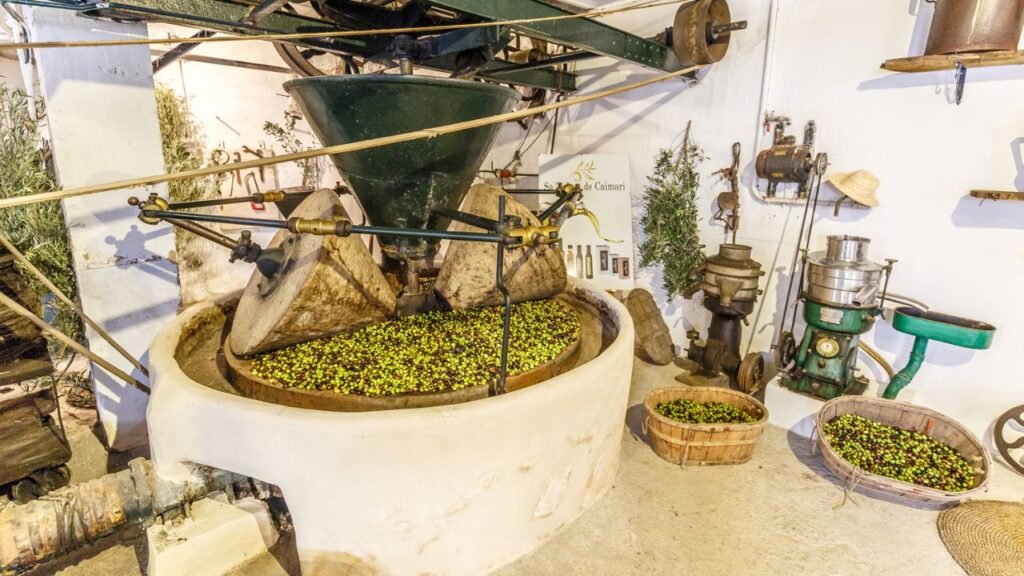
The Serra de Tramuntana are filled with thousands of ancient, gnarled olive trees specific to the island, such as the Mallorquina, the Arbequina, and the Picual varieties. It’s estimated that the majority of Mallorca’s olive trees have an average age of five hundred years. The trees’ age, the Mediterranean climate, and the island’s soil composition all contribute to producing an oil known for its intense and fruity flavor. Mallorcan oil has been a designation of origin product since 2002. To recognize Mallorcan oil, look for the “D’O” and “Oli de Mallorca” labels that guarantee that the oil has been completely produced on the island and without added chemicals.
Almonds
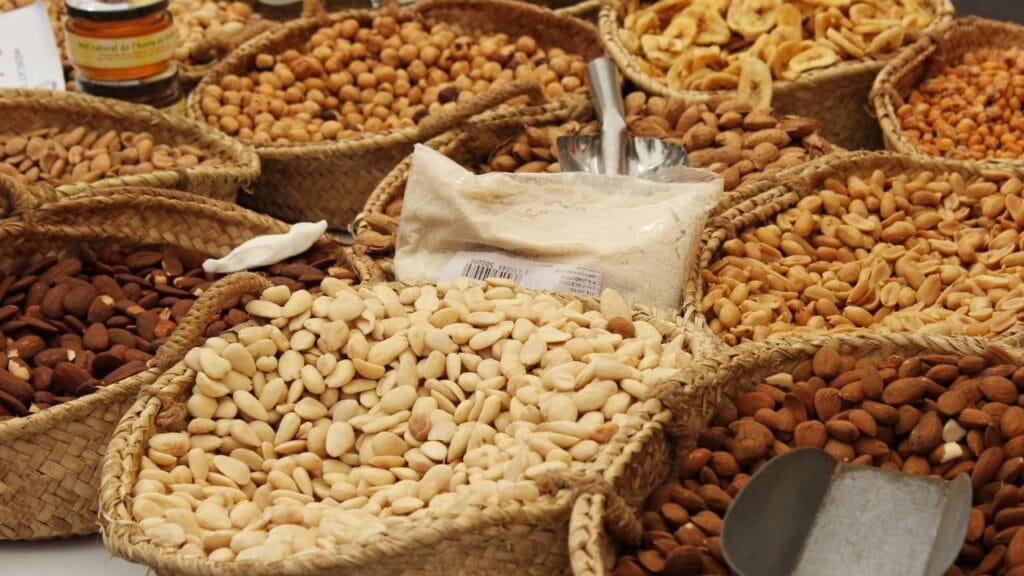
In the lower, flatter, more central parts of the island, you can find the almond groves, something that is especially beautiful in the early days of spring when the white and pink blossoms explode. Besides being a gorgeous emblem of spring, Mallorcan almonds are well renowned among confectioners. Mallorca’s almond trees are not very productive varieties, but they produce a high quality and delicious product. Mallorcan almonds are considered among the world’s finest.
Salt
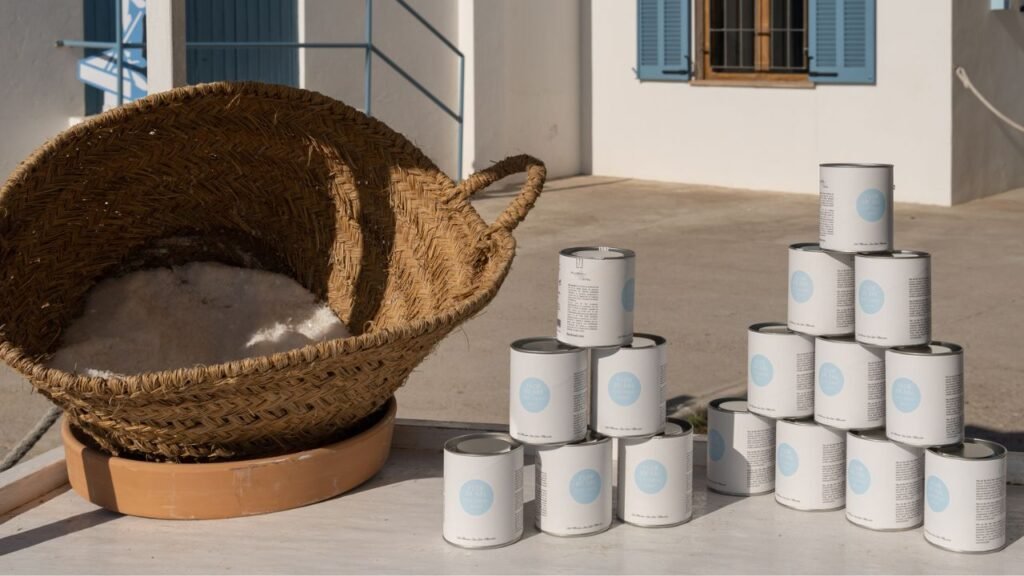
On the southeast of the island, you can find the salt flats. The zone, near the stunning Es Trenc, is biologically rich and diverse with bird life, including flamingos at some times of year, but it also produces a delicious natural sea salt. Flor de Sal has shops scattered around the island, including one in Plaça Cort.
Oranges
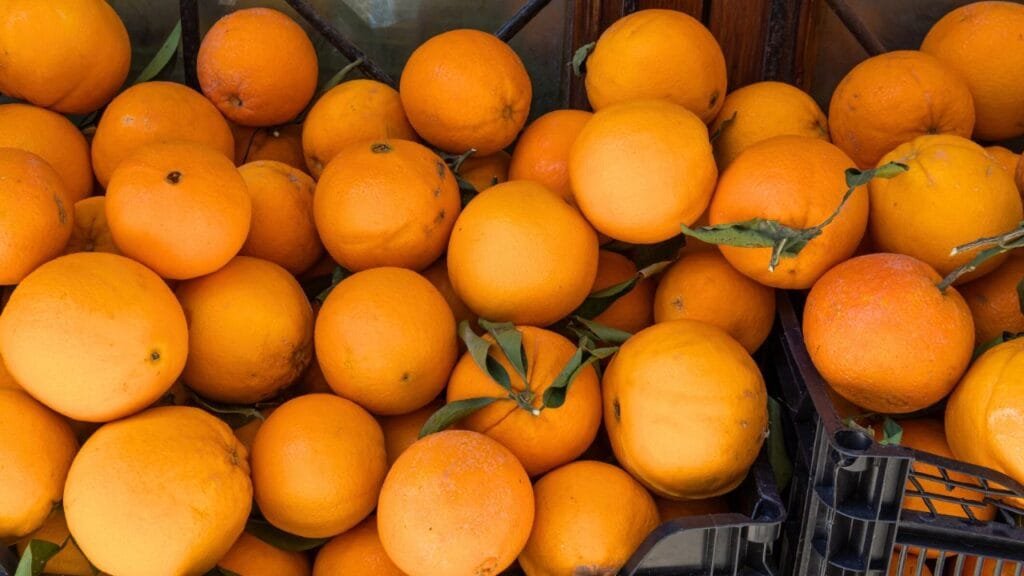
The Sóller valley is filled with groves that produce world-renowned oranges. The valley’s warm, moist climate is ideal for citrus cultivation. The town proudly advertises their oranges everywhere, selling fresh-squeezed “Sóller orange juice” as well as a variety of orange products like the “Sóller bomb,” a concoction made up of orange juice and ice cream. If you wander Sóller’s stone streets, or even those of other nearby pueblos, during the peak of orange season, there’s the possibility you’ll find a basket of citrus with a jar and paper sign offering oranges and lemons for cash as the locals sell their surplus.
Snacks
Galletes d’Oli
Mallorcan oil crackers are an incredibly tasty, delightfully crunchy snack that you should definitely bring to the beach, on a hike, or enjoy paired with something as a tapa. They are an amazing accompaniment to fuet or are great with chocolate, two versions that are so popular that the brand Quely—the largest and most well-known producer—sells pre-packaged versions of both for school snacks. You can top them with sobrasada or pair them with cured meats and cheeses. They also can be incorporated into tapas. There are plain ones and also flavored. Sunflower seed ones are also fantastic.
While Quely is the most well-known, other brands to keep an eye out for are Forn de Sa Plaça—one of my personal favorites, which also produces a chocolate-esque carob cracker—Gori de Muro, and Galletes Rossellons.
Food Festivals
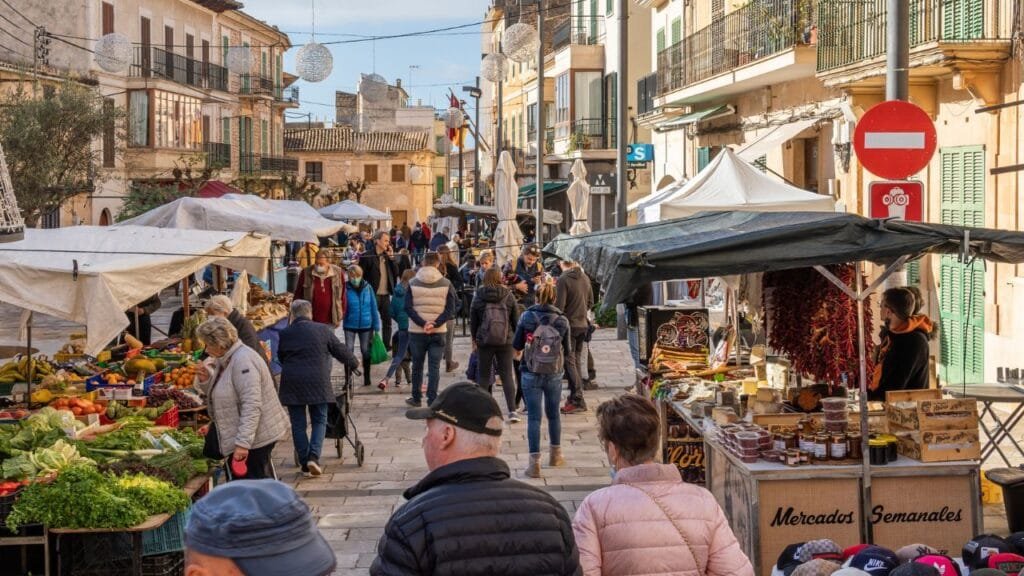
The most fun way to sample Mallorcan gastronomy and immerse yourself in local culture is to go to one of the island’s many food fairs. Across the island, different towns celebrate their main crops and industries, complete with—the best part—food stalls, live music, and activities for all ages.
Fira de la flor d’ametler—Son Servera
The first weekend of each February, Son Servera hosts the annual almond fair at the historic finca of Ca S’Hereu. It takes place as the almonds are starting to bloom. There are market stalls with almond-based products, displays of equipment used in almond cultivation and harvest, and live music.
Fira de la Taronja—Sóller
Sóller, Port de Sóller, and Fornalutx celebrate their main crop in late March and early April with a packed program that includes markets, competitions, exhibitions, live music, and tours. It’s a great opportunity to immerse yourself in a beautiful, agriculturally rich part of Mallorca and enjoy the best of the island’s citrus products while learning some history and enjoying local talent.
Fira de l’Sípia—Port d’Alcudia
In April, Port d’Alcudia hosts a cuttlefish fair, a type of seafood that makes its way into many Mallorcan dishes. The festival not only celebrates sepia, but also maritime traditions. There’s a multi-day program with a market, gastronomic showcase, and live music.
Fira de la Sal i Salaons—Colonia Sant Jordi
In April, Colonia Sant Jordi celebrates the area’s long history of salt production with a fair that showcases Mallorcan salt’s uses in local gastronomy as well as the possibility to tour the salt flats. This fair contains markets, live music, activities for children, tastings, etc.
Fira de la Patata—Sa Pobla
If you’re a potato lover, come to Sa Pobla in early June as they celebrate one of their main crops. There are a plethora of food stalls around Plaça Major paying homage to the humble potato. You can find frit Mallorquin, bombas, and even potato ice cream. A small town, it is a simple but delicious festival. Come to eat and enjoy the live music that goes late into the night.
Fira Gastronomica D’es Pop—Portocolom
In June, the fishing village of Portocolom is the place to go to enjoy the best of Mallorca’s octopus dishes. Over three days, there are markets, food stalls, live music, and other activities.
Dijous Bo—Inca
Every third Thursday of November, Inca turns into one large street market. There are hundreds of stalls and vendors from all over the island, ranging from local food products to artisan goods. The night before, Dimecres Bo, you can enjoy the ambience of the sprawling market while enjoying the street food vendors. In Plaça des Bestiar, you can get close to the animal side of agriculture with an exhibition of local animals, including porc negre as well as lots of poultry.
Fira de s’Oliva—Caimari
Each autumn at the foot of the Serra Tramuntana, Caimari hosts a charming olive fair that showcases Mallorcan olive products, from olives and olive oil to things made of olive wood. There is also an olive oil museum to visit. The fair takes place towards the end of November and also includes a market, live music, and activities.

